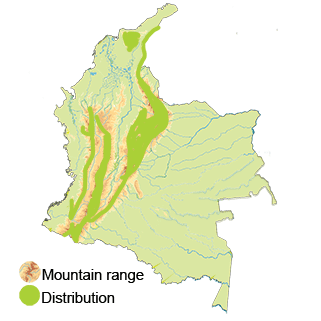Greater Band-winged Nightjar
The Greater Band-winged Nightjar (Systellura longirostris) Read in Spanish
Appearance: The Greater Band-winged Nightjar is a medium-sized nightjar with cryptic plumage that provides excellent camouflage against its typical forest floor habitat. It has a distinctive pattern of bold white wing bars and white tips on the tail feathers. The bird has a long, slender bill and a wide mouth adapted for catching flying insects at dusk and dawn.
Habitat: In Colombia, the Greater Band-winged Nightjar is primarily found in lowland and foothill forests, especially in humid and tropical forest environments. It prefers areas with dense undergrowth, leaf litter, and open spaces for foraging. These nightjars are often associated with mature forests and forest edges, where they can roost and nest on the ground.
Behavior: Greater Band-winged Nightjars are nocturnal birds that are most active during the twilight hours. They are skilled aerial foragers, feeding on insects such as moths, beetles, and flying ants. These nightjars have a distinctive flight pattern with agile maneuvers and silent wingbeats as they hunt prey in the dim light of dusk and dawn.
Breeding: Breeding behavior in Greater Band-winged Nightjars involves courtship displays, territorial calls, and nesting on the forest floor. The female usually lays two eggs directly on the ground, relying on their cryptic plumage to conceal the nest. Both parents share nesting duties, with the male often incubating the eggs during the day.
Conservation Status: The conservation status of the Greater Band-winged Nightjar in Colombia is not well-documented due to limited research and monitoring efforts.
Distribution
The Greater Band-winged Nightjar (Systellura longirostris)
Andean Region: The Andean region of Colombia, which includes the departments of Antioquia, Boyacá, Cundinamarca, and others, also provides habitat for the Greater Band-winged Nightjar. While these areas are characterized by montane and cloud forests, the nightjar may be found in suitable habitats at different elevations within the Andean region.
Taxonomy
The Greater Band-winged Nightjar (Systellura longirostris)
- Kingdom: Animalia
- Phylum: Chordata
- Class: Aves (Birds)
- Order: Caprimulgiformes
- Family: Caprimulgidae
- Genus: Systellura
- Species: Systellura longirostris
Vocalization
The Greater Band-winged Nightjar (Systellura longirostris)
- Calls: The vocalizations of the Greater Band-winged Nightjar typically consist of a series of repetitive, melodious notes or phrases. These calls can vary in pitch, rhythm, and intensity, serving different purposes depending on the context.
- Churring Call: One of the most characteristic vocalizations of the Greater Band-winged Nightjar is a churring call, often described as a rhythmic, rolling sound. This call is produced by the male bird during courtship displays and territorial behaviors. The churring call can be loud and distinctive, carrying through the night in the forest.
- Other Vocalizations: In addition to the churring call, the Greater Band-winged Nightjar may produce other vocalizations such as whistles, trills, and clicking sounds. These vocalizations can vary in complexity and are used for communication with mates, offspring, and rivals.
- Timing: Greater Band-winged Nightjars are primarily nocturnal birds, and their vocalizations are most commonly heard at dawn and dusk when they are most active. The birds may vocalize from perches in the forest canopy or while in flight during their hunting forays.
- Function: The vocalizations of the Greater Band-winged Nightjar serve various functions, including attracting mates, establishing territories, and signaling alarm. The distinctive calls help individuals recognize and communicate with each other in the dense forest environment where visual cues may be limited.
- Field Identification: Birdwatchers and researchers can use the unique vocalizations of the Greater Band-winged Nightjar as a field identification tool to locate and identify individuals in their habitat. Familiarity with the bird's calls can aid in surveying populations and studying their behavior in the wild.




